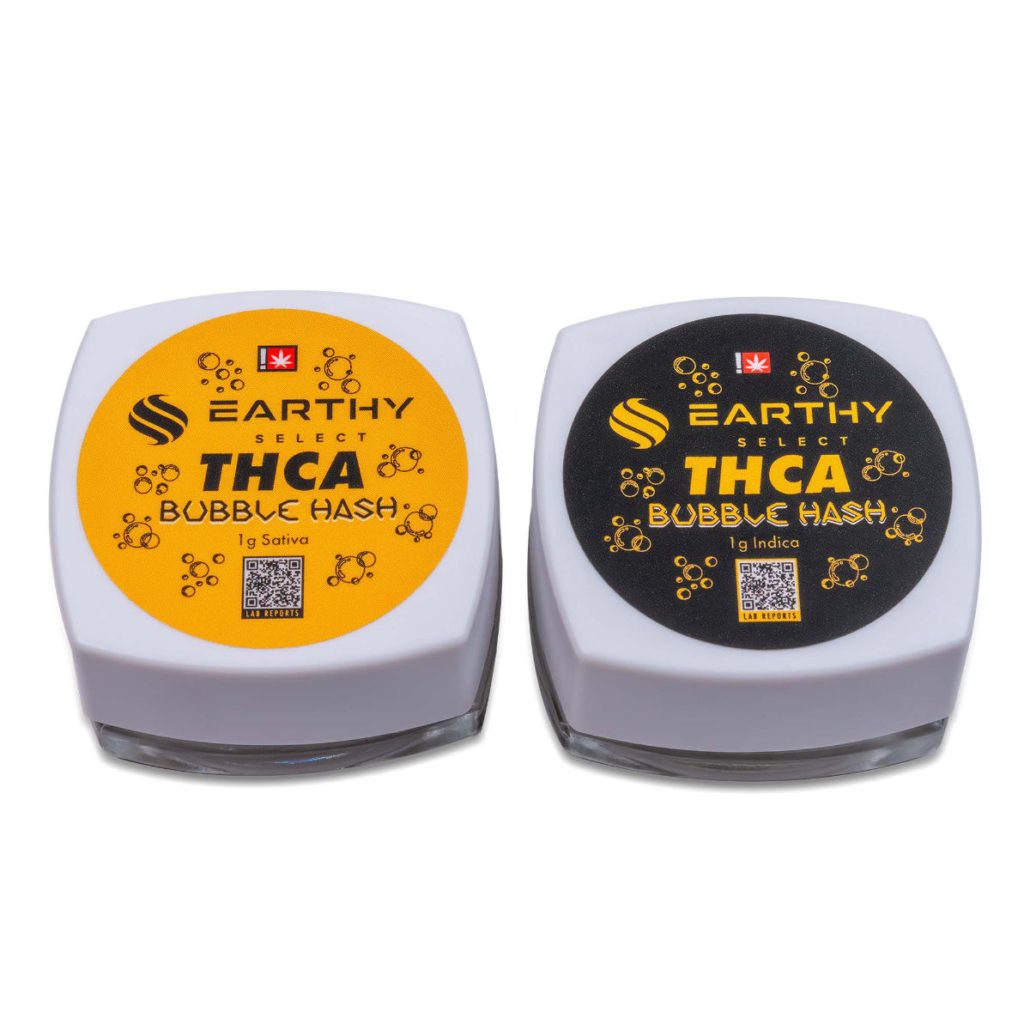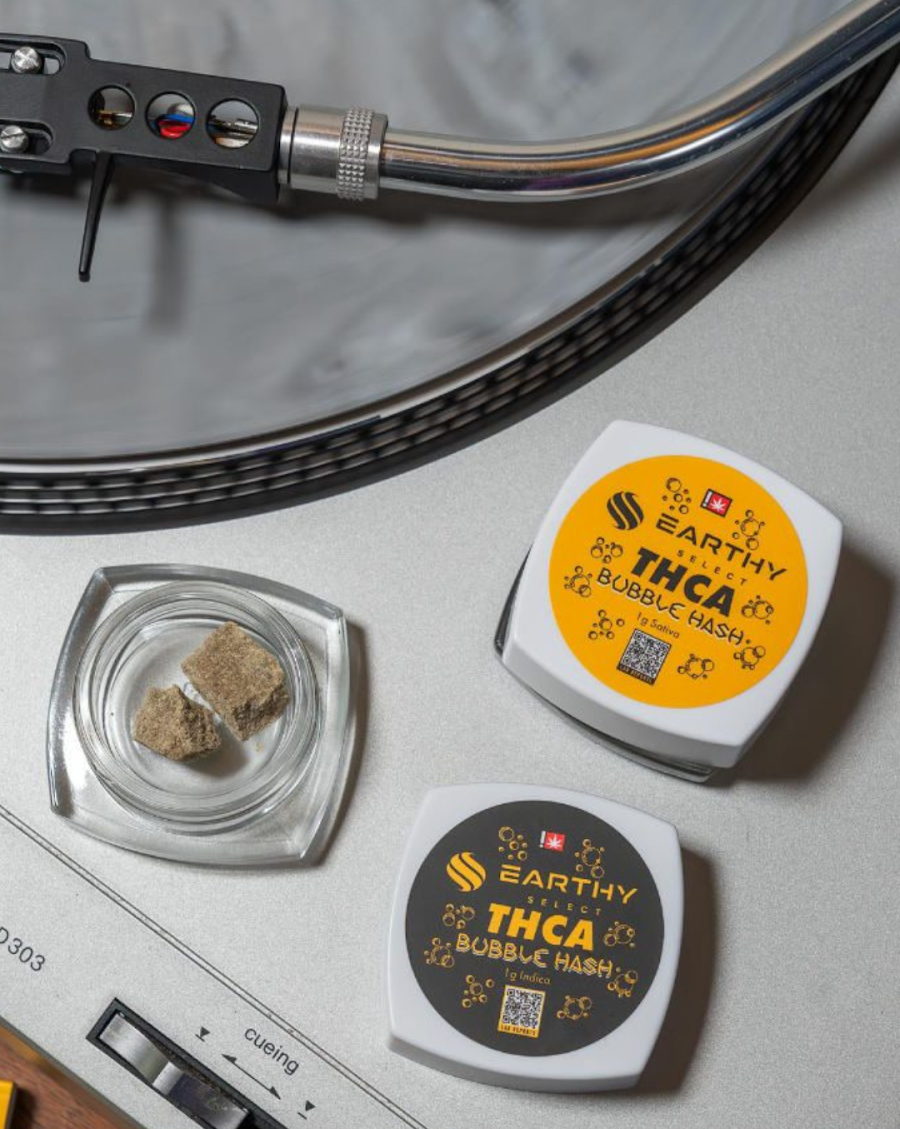THCa Hash
$50.00
THCa Bubble Hash - Deep Flavor and Effects
THCa Hash is quickly becoming a standout in the world of cannabis concentrates. This format blends refined extraction with cannabinoid science to deliver a clean, high-potency experience made for those who want more from their hemp. Whether you’re an experienced consumer or exploring modern cannabis for wellness, THCa Hash offers something bold and reliable.
At Earthy Select, we specialize in lab-tested, federally legal THCa products crafted for consistent effects and rich terpene profiles. From our home base in Asheville, each batch of THCa Hash is created with precision, so you can enjoy strong, plant-forward effects that suit your body, mindset, and routine. Let’s discuss what THCa Hash is, how it’s made, how it works with your body, and why it stands apart from other concentrates on the shelf.
From Plant to Potency: How THCa Hash Is Made
THCa Hash isn’t a crumble of dusty kief pressed on a whim. Instead, it’s the result of meticulous extraction that preserves the natural potency of hemp while respecting the plant’s full chemical fingerprint. Every step is about protecting what matters most: the raw THCa inside sparkling trichomes. Below, we break down how modern hash makers extract and refine THCa Hash, from flash-freezing fresh flower to fine-tuning flavor and texture.
Harvest and Flash-Freeze: Preserving Trichomes at Their Peak
The journey begins just after harvest. Cannabis is clipped at peak maturity, while the trichomes are still full of cannabinoids and terpenes. To preserve this resin-rich state, growers flash-freeze the flower almost immediately. This step prevents oxidation and protects the fragile THCa from breaking down under heat or exposure.
Flash-freezing also locks in the aromatic compounds that contribute to the flavor profile, which makes a big difference later when the final product is vaporized or smoked. Frozen material holds up better during extraction and helps hash makers keep the plant’s integrity intact. This step may seem simple, but it’s one of the most important moves in protecting the concentrate’s therapeutic potential.
Trichome Separation: Solventless vs. Solvent-Based Extraction
Once the frozen cannabis is prepped, it’s time to remove the trichomes from the rest of the plant. This step can follow one of two paths: solventless or solvent-based extraction.
Solventless methods are often preferred for a cleaner, more flavorful result. In ice water extraction, for example, the plant is stirred gently in cold water, which knocks the trichomes loose. These trichomes are then filtered out, dried, and collected. Dry sift is another solventless approach, where screens with different microns are used to shake off the resin without introducing water or chemicals. The result is a pile of granular hash full of raw THCa and natural terpenes.
In contrast, solvent-based extraction relies on chemicals like butane or CO₂ to dissolve cannabinoids and terpenes from the plant material. While this method can produce high yields, it requires extensive post-processing to remove the solvents and ensure safety. Solventless extraction, on the other hand, avoids these added steps by using only heat, pressure, or ice water, resulting in a cleaner, more natural concentrate that’s free from chemical residues.
Purifying and Pressing: Shaping Texture Without Triggering Heat
Once the trichomes have been gathered, the material is shaped into a usable form. Solventless hash is often pressed into bricks or patties using light heat and pressure. The goal is to bind the trichomes without triggering decarboxylation. This means pressing must be done with care, just enough to shape the hash and concentrate the texture without altering its chemical profile.
Solvent-based concentrates often go through additional refinement processes such as winterization or micro filtration to remove waxes, fats, and plant lipids that may affect flavor or combustion. While these steps can improve the appearance and texture of the final product, they can also strip away some of the plant’s natural qualities. Solventless extraction avoids chemical processing altogether, helping to preserve the full spectrum of cannabinoids and terpenes for a cleaner and more authentic cannabis experience.
Curing and Storage: Locking in Aroma, Potency, and Stability
After shaping, the hash is left to cure. This means resting the product in a dark, cool environment where it can settle and stabilize. Curing gives the terpenes time to mature and allows the texture to balance out. The aroma becomes fuller, the consistency firms up, and the final product becomes easier to handle without compromising quality. Storage is just as crucial as THCa is sensitive to heat and light. At Earthy Select, we seal our concentrates in airtight containers designed to block UV exposure and prevent moisture intrusion.
Why THCa Feels Different
THCa, or tetrahydrocannabinolic acid, is the raw, non-psychoactive precursor to the THC everybody knows and loves. Let’s peel back the layers on THCa Hash and get to the fun part: the science that makes this cannabinoid concentrate so compelling.
Potential Benefits of THCa Hash
- Helps promote deeper sleep and nighttime relaxation: THCa Hash may support better sleep onset and more restful nights when paired with Indica strains. It’s a popular nighttime companion for those managing overstimulation or burnout.
- Encourages calm focus and mental clarity during the day: In smaller amounts, THCa Hash derived from Sativa strains can provide a clear-headed lift that helps soften mental noise and ease distractions. Some people use it during mid-morning or creative sessions to stay present and engaged.
- May reduce anxiety and restlessness in low doses: Users looking for gentle mood balance without overwhelming psychoactive effects often reach for Hybrid THCa Hash in low doses. Terpenes like myrcene and limonene may contribute to its relaxing, steady vibe.
- Delivers stronger effects with smaller doses compared to flower: Once activated, THCa Hash produces a quicker onset and more concentrated impact than traditional smoking flower. This makes it a good match for people who want faster results or need smaller amounts to feel the desired effect.
How THCa Interacts with the Body Before and After Heat
THCa starts as a raw cannabinoid nestled inside the trichomes of a cannabis plant. In this unheated form, it is non-psychoactive and doesn’t bind directly to the CB1 receptors in the brain. That’s why users who consume raw THCa don’t experience a “high.” Instead, the compound may interact with other parts of the endocannabinoid system to support balance and reduce inflammation.
When THCa Hash is heated during dabbing, vaporizing, or smoking flower, the molecule undergoes a transformation called decarboxylation. This process removes a carboxyl group and converts THCa into Delta-9 THC. Once converted, THC binds to CB1 receptors in the brain, activating euphoric, sedative, or uplifting effects based on the strain, terpene profile, and dosage.
The speed of this transformation is one reason concentrates feel more immediate than edibles or traditional flower. Dabbing or vaporizing THCa Hash delivers activated cannabinoids straight to the bloodstream through the lungs, allowing the effects to begin within minutes. This makes it easier to adjust your experience in real time, whether you’re seeking creative energy or slow, full-body relaxation.
THCa vs. Delta-8, Delta-9, and Delta-10: What’s the Difference?
As cannabis enthusiasts continue to explore the myriad of cannabinoids out there, understanding the differences between THCa and its cousins – Delta-8, Delta-9, and Delta-10 – becomes essential. At Earthy Select, we’re here to break it down for you in the simplest terms.
THCa: The Precursor Cannabinoid
THCa, or tetrahydrocannabinolic acid, is the non-psychoactive precursor to THC. In its raw form, THCa doesn’t cause a high, which makes it unique among its siblings. The magic happens when THCa is decarboxylated through heat, converting it into THC, the well-known psychoactive compound responsible for the euphoria consumers seek.
Delta-8, -9, and -10 Variants
- Delta-8 THC: Known for its milder psychoactive effects compared to Delta-9, Delta-8 provides a smoother, less intense high. It’s a fantastic option for those seeking relaxation without the heavy sedation that sometimes accompanies cannabis.
- Delta-9 THC: The superstar of cannabinoids, Delta-9 is the main psychoactive compound in cannabis. It’s the THC majority of users are familiar with, thanks to its intense psychoactive and euphoric effects.
- Delta-10 THC: This newcomer to the cannabinoid scene offers an uplifting, sativa-like high. It’s gaining traction for its energizing effects, which can enhance focus and creativity.
Read more:
Frequently Asked Questions About THCa Hash
What is the THC content in THCa Hash?
THCa Hash is known for its sky-high potency. The actual THC content depends on two things: the purity of the hash and how it’s consumed. Before it’s heated, THCa Hash is packed with THCa (tetrahydrocannabinolic acid). When you smoke or vaporize it, THCa converts into Delta-9 THC, unleashing those strong effects. Potency can easily surpass 50% Delta-9 THC by weight after decarboxylation, making it one of the most concentrated forms of cannabis out there.
How should THCa Hash be stored?
Think dark, cool, and airtight. To keep your THCa Hash as fresh and potent as possible, store it in a tightly sealed jar away from direct sunlight, heat, and humidity. A glass container tucked in a drawer or cupboard works wonders. Keeping it cool will slow down the degradation of cannabinoids, preserving both potency and flavor. Pro tip: If you’re not planning to use it soon, a fridge is even better.
How does THCa Hash affect the body?
The science here is fascinating. When you smoke or dab THCa Hash, the heat kicks off a process called decarboxylation, turning THCa into Delta-9 THC—the cannabinoid responsible for the “high.” Users report classic cannabis effects: euphoria, relaxation, enhanced sensory experiences, and an overall uplifted mindset. Effects are stronger and arrive faster than smoking flower due to the concentrated format.
Can THCa Hash go bad?
Absolutely, like any natural product, THCa Hash can degrade over time. Exposure to air, light, and heat can cause it to lose potency, dry out, or even grow mold if there’s excess moisture. Proper storage is your friend here. When kept in the right conditions, quality THCa Hash can last for months without losing its magic.
Can THCa Hash be used in edibles?
Yes, but there’s a catch! Since THCa isn’t psychoactive on its own, you’ll need to decarboxylate (heat) it first to activate the THC. You can gently heat THCa Hash in the oven before incorporating it into homemade edibles. Or, look for recipes that include a step for decarbing your concentrates to get the effects you’re after.
How do you dose THCa Hash?
Since THCa Hash is so potent, a little goes a long way. If you’re smoking or dabbing, try a rice-grain-sized dab and see how you feel before reaching for more. Edible dosing can be trickier—always calculate how much THC you’re working with after decarboxylation, and start with a small amount to avoid going overboard.
Does THCa Hash smell like regular cannabis?
Absolutely! THCa Hash retains the terpene profile of the source plant, so you’ll notice that pungent, unmistakably “cannabis” aroma. Depending on the strain, expect anything from earthy and herbal to sweet and fruity notes. The smell packs a punch—so be discreet if you need to be.
Medical Disclaimer / Legal Disclaimer – Information is provided for educational purposes only. It does not, and is not intended to, constitute legal advice or medical advice. We strive to be accurate and up-to-date, but the legality of cannabinoids and the science of cannabis are continually evolving. The author is neither a legal professional nor a medical expert. Before buying or using any products, you should consult with your local authorities and medical providers.
Sources:
- Baron, E. P. (2018). Medicinal properties of cannabinoids, terpenes, and flavonoids in cannabis, and benefits in migraine, headache, and pain: An update on current evidence and cannabis science. Headache: The Journal of Head and Face Pain, 58(7), 1139–1186. https://pubmed.ncbi.nlm.nih.gov/30152161/
- Cenikor Foundation. THCa information. https://www.cenikor.org/resources/THCa-info/
- U.S. Food and Drug Administration. (2024). FDA regulation of cannabis and cannabis-derived products, including cannabidiol (CBD). https://www.fda.gov/news-events/public-health-focus/fda-regulation-cannabis-and-cannabis-derived-products-including-cannabidiol-cbd.

